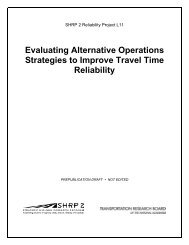Annotated Bibliography - SSTI
Annotated Bibliography - SSTI
Annotated Bibliography - SSTI
You also want an ePaper? Increase the reach of your titles
YUMPU automatically turns print PDFs into web optimized ePapers that Google loves.
Title<br />
Authors<br />
Sponsor<br />
Public Transportation: Federal Role in Value Capture Strategies for Transit is Limited, but<br />
Additional Guidance Could Help Clarify Policies<br />
United States Government Accountability Office (GOA)<br />
GOA‐10‐781<br />
Date July, 2010<br />
Pages 55<br />
Category<br />
Note<br />
Online<br />
Summary<br />
Mode: Transit; Economic results<br />
http://www.gao.gov/new.items/d10781.pdf<br />
The GAO has documented the use of value capture techniques around transit<br />
investment through assessing strategies considered or used at 55 transit properties.<br />
Techniques used include: joint development, special assessment districts, tax increment<br />
financing, and development impact fees. The authors dtermined that the percentage of<br />
a project’s cost covered by examples for 9 transit systems ranges 4% for a bus tunnel in<br />
Seattle to as much as 61% for the new Beltline in Atlanta.<br />
Success is dependent in most instances on the cooperation and partnerships that are<br />
developed among the transit agency and the local government, adjacent property<br />
owners, and/or private developers. Other important factors for success noted include:<br />
density and zoning around the station, favorable economic conditions, and low crime<br />
rates. State law also must allow the establishment of special assessment districts, tax<br />
increment financing, and development impact fees. It was noted that some states such<br />
as California and Maryland have allowed transit agencies to create assessment districts<br />
within certain distance of stations. Confusing rules of the Federal Transit Administration<br />
and the requirement for 1 to 1 parking space replacement were cited as barriers.<br />
<strong>Annotated</strong> <strong>Bibliography</strong> Page 36















